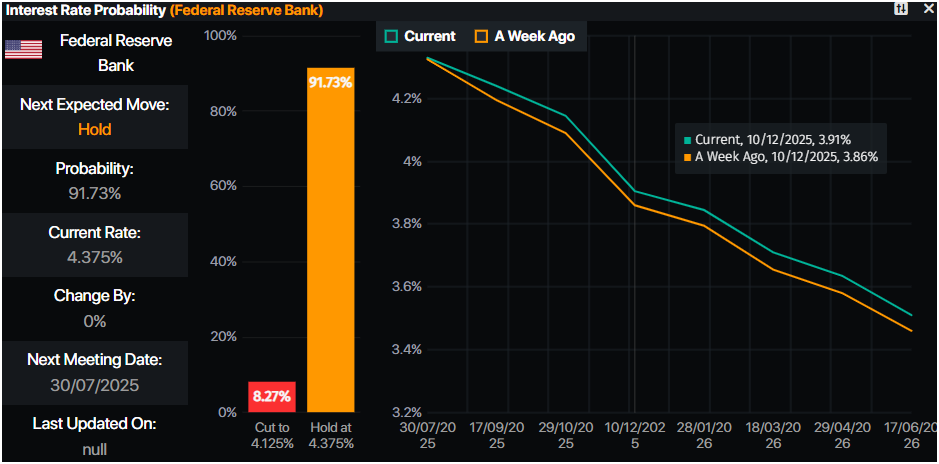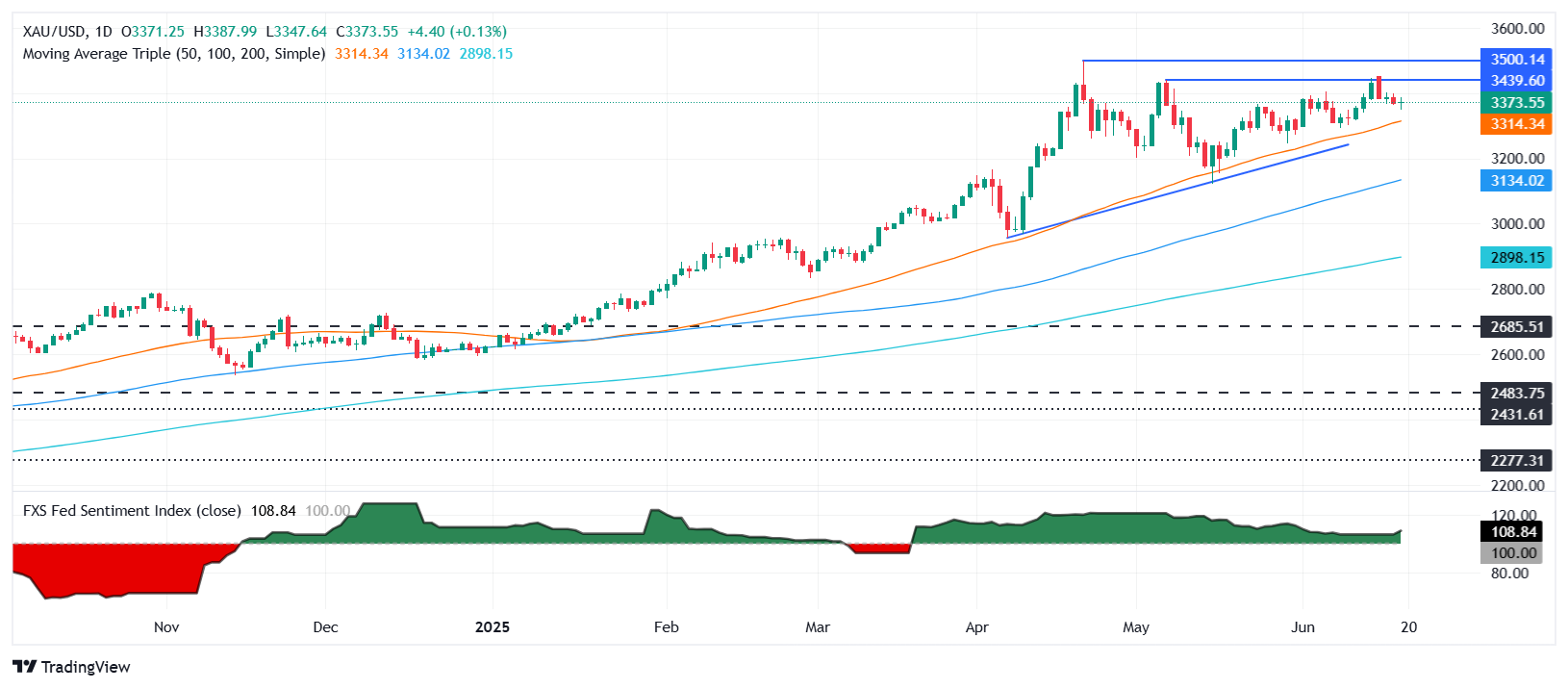Gold climbs above $3,370 despite Fed turning hawkish, US eyes Iran strike
- Gold appreciates 0.14% as Fed signals just one cut in 2026, shifting slightly hawkish.
- Reports say Trump approved Iran strike plans, fueling safe-haven US Dollar demand.
- Traders eye Philly Fed data next as thin holiday trading keeps risk appetite subdued.
Gold price registers modest gains on Thursday as geopolitical tensions rose due to increasing rumors that the United States (US) might become involved in the Israel–Iran conflict. Nevertheless, a slightly hawkish Federal Reserve (Fed) caps the golden metal's advance. At the time of writing, XAU/USD trades at $3,373, up 0.13%.
Geopolitics continued to drive Gold’s price action due to reports from several US news websites like The Wall Street Journal and CBS News revealing that plans of a US attack on Iran nuclear facilities had been approved by US President Donald Trump, who is weighing his options for a diplomatic exit.
Equity futures in the US are dropping, while the US Dollar remains bid amid thin trading as US markets remain closed in observance of the Juneteenth holiday.
On Wednesday, the Fed held rates unchanged and updated its economic projections, in which officials revealed that they’re still expecting two cuts in 2025. Still, for the next year, they anticipate just one instead of two cuts, turning slightly hawkish as they see inflation remaining above the 2% goal.
Fed Chair Jerome Powell commented that policy is in a good place despite being moderately restrictive. He acknowledged that the impact of tariffs has yet to be felt, adding that someone — either the manufacturer, intermediary or consumer — has to pay for it.
Although Gold has dipped, it is typically sought during geopolitical tensions and lower interest rate environments; the Fed’s restrictive tilt might prompt investors to turn toward other currencies alongside the US Dollar.
Ahead this week, traders will be eyeing the Philadelphia Fed Manufacturing Index for June, which is expected to move from -4 to -1.
Daily digest market movers: Gold price rises though the Fed tilts hawkish
- The Fed left the target range for the fed funds rate unchanged at 4.25%–4.50%, reaffirming that the US economy continues to expand at a solid pace, with labor market conditions remaining strong.
- The Summary of Economic Projections (SEP) showed a slight downgrade in the 2025 GDP growth outlook to 1.4% from 1.7% in March. The Unemployment Rate forecast was revised up to 4.5% from 4.4%, while the core PCE inflation projection rose to 3.1% from 2.8%.
- Fed Chair Jerome Powell stood to his mildly neutral-hawkish stance on his press conference, reaffirming that monetary policy is “well positioned to respond” to external shocks like tariffs or geopolitical risks.
- Furthermore, Powell added, “the effects of tariffs will depend on the level,” and that “increases this year will likely weigh on economic activity and push up inflation.” He said, “As long as we have the kind of labor market we have and inflation coming down, the right thing to do is hold rates.”
- The US Dollar Index (DXY), which tracks the performance of the Dollar against six major currencies, edges up 0.19% to 99.03.
- US Treasury yields remain unchanged, with the US 10-year Treasury yield currently at 4.391%. US real yields followed suit, at 2.081%.
- The World Gold Council's latest survey on central banks revealed that the majority of the 73 polled expect an increase in demand, which could underpin Bullion prices.
- Money markets suggest that traders are pricing in 46 basis points of easing toward the end of the year, according to Prime Market Terminal data.

Source: Prime Market Terminal
XAU/USD technical outlook: Gold price to remain pressured below $3,400
Gold consolidates near weekly lows of $3,347 amid investors' reluctance to push the spot price above $3,400, which opened the door for a pullback. The Relative Strength Index (RSI) suggests that buyers are losing momentum as the golden metal trades sideways.
For a bullish resumption, XAU/USD must clear $3,400. Once cleared, this will expose key resistance levels like the $3,450 mark and the record high of $3,500 in the near term.
Otherwise, if Bullion drops below $3,370, the pullback could extend toward the $3,350 mark and to the 50-day Simple Moving Average (SMA) at $3,308. Further losses are seen once cleared at the April 3 high-turned-support at $3,167.

Gold FAQs
Gold has played a key role in human’s history as it has been widely used as a store of value and medium of exchange. Currently, apart from its shine and usage for jewelry, the precious metal is widely seen as a safe-haven asset, meaning that it is considered a good investment during turbulent times. Gold is also widely seen as a hedge against inflation and against depreciating currencies as it doesn’t rely on any specific issuer or government.
Central banks are the biggest Gold holders. In their aim to support their currencies in turbulent times, central banks tend to diversify their reserves and buy Gold to improve the perceived strength of the economy and the currency. High Gold reserves can be a source of trust for a country’s solvency. Central banks added 1,136 tonnes of Gold worth around $70 billion to their reserves in 2022, according to data from the World Gold Council. This is the highest yearly purchase since records began. Central banks from emerging economies such as China, India and Turkey are quickly increasing their Gold reserves.
Gold has an inverse correlation with the US Dollar and US Treasuries, which are both major reserve and safe-haven assets. When the Dollar depreciates, Gold tends to rise, enabling investors and central banks to diversify their assets in turbulent times. Gold is also inversely correlated with risk assets. A rally in the stock market tends to weaken Gold price, while sell-offs in riskier markets tend to favor the precious metal.
The price can move due to a wide range of factors. Geopolitical instability or fears of a deep recession can quickly make Gold price escalate due to its safe-haven status. As a yield-less asset, Gold tends to rise with lower interest rates, while higher cost of money usually weighs down on the yellow metal. Still, most moves depend on how the US Dollar (USD) behaves as the asset is priced in dollars (XAU/USD). A strong Dollar tends to keep the price of Gold controlled, whereas a weaker Dollar is likely to push Gold prices up.



